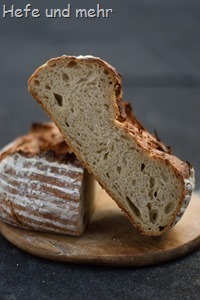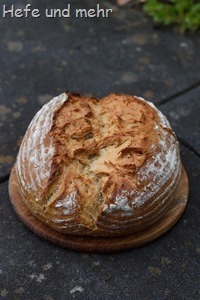 Autumn means always potato time for me. And even after this hot and endless summer, when we had to harvest them already in august due to the drought, I hunger for the first loaf of potato bread. Here – in the region around cologne – potatoes are called Ärpel or Erpel. This dialectal term is a short form from “Erdapfel” (literal earthapple). And so is an Ärpelbrot nothing other then a potato bread.
Autumn means always potato time for me. And even after this hot and endless summer, when we had to harvest them already in august due to the drought, I hunger for the first loaf of potato bread. Here – in the region around cologne – potatoes are called Ärpel or Erpel. This dialectal term is a short form from “Erdapfel” (literal earthapple). And so is an Ärpelbrot nothing other then a potato bread.
These Variant is in some points similar to the Oberbergischen Ärpelbrot but is baked with a rye poolish and yeast. And so it is a variant that works well for bread baking beginners too. It is a aromatic bread whit crisp crust and tender crumb.
For me, it is the right bread to eat it – thickly slathered with Plum butter – on a cold, misty autumn morning!
Ärpelbrot
Rye poolish
- 150g whole rye flour
- 300g Water
- 1g fresh yeast
Dough
- Rye poolish
- 400g starchy potatoes
- 150g whole rye flour
- 600g flour Type 550
- 30g Butter
- 16g fresh yeast
- 30g molasse
- 24g Salt
- 40g Water if needed
Mix ingredients for the poolish and ferment it overnight (12 hours).
Cook the potatoes, peel them and mash them. Let the mashed potatoes cool down to room temperature
Now mix all ingredients for the dough, and knead it 10-15 min by hand.
Let the dough rise to 2 hours
Shape the dough into two oval loaves and place them seam side down in a proofing basket.
Proof for 1 hour. In the meantime preheat oven and baking stone.
Bake for 10 min at 250°C with steam on a hot stone, then turn reduce the temperature to 200°C and bake another 45min. For a extra crisp crust turn on convection mode during the last 10 min.
Deutsch




Hallo Stefanie,
was für ein tolles Rezept, danke dafür. Ich mag ja die Roggen-Hefe Vorteige sehr und das ist eines der besten Brote die ich bis jetzt gebacken habe. Der Teig war super handhabbar und hat locker die 40ml Extra-Wasser vertragen, die Garzeiten passten auch astrein. Beim nächsten Mal probiere ich lediglich mal nur 20g statt 30g Rübenkraut, die Süße könnte ein wenig dezenter sein.
Ich habe den Teig nicht geteilt und im Topf gebacken hat es sich dann nochmal mehr als verdoppelt. Wir konnten es nicht mehr erwarten und haben angeschnitten bevor es ganz kalt war. . Tolle Kruste und supersofte Krume, auch am nächsten Tag noch genau so weich und elastisch. Das gibt’s jetzt regelmäßig und das Schöne ist, das ich sogar das Poolish morgens ansetzen und das Brot Abends backen könnte. Das passt super in meinen Zeitplan.
@Jens: Das freut mich sehr 😀 Das Brot steht bei mir auch sehr hoch im Kurs!
kann ich das Rübenkraut durch irgendetwas ersetzen? oder einfach weglassen? danke! lg
@M: Du kannst es durch inaktives Malz ersetzen oder weglassen. Es dient nur dem Aroma.
super, danke! malz ist vorhanden 😉 Lg!
Hallo Stefanie, ich finde grade die Umrechnungsmodalitäten bzgl frischen Kartoffeln und dem Pellkartoffelpulver nicht mehr. Könntest du mir aushelfen? Danke und lieben Gruß, Jasmin
@Jasmin: 100g Kartoffel entspricht in etwa 20g Pellkartoffelpulver und 80g Wasser
Ha,
die letzten Reste vom Oberbergischen gerade verspeist, da kommt ein Nachfolge-Rezept!
Ich bleibe als Sauerteig-Fan dem (etwas abgewandelten) Originalrezept treu, behalte dieses aber für den Fall der Fälle mal im Hinterkopf.
Gerade eben noch das Onjeschwedde zum Brötchenteig umfunktioniert, so ähnlich wie beim Berchtesgadener Stuck, so aber mit mehr Roggen-Anteil, und die Zimtmenge verdoppelt: Besser geht nicht :))
Liebe herbstliche Grüße
sendet
Isa